Histone modifications, but not nucleosomal positioning, correlate with major histocompatibility complex class I promoter activity in different tissues in vivo
- PMID: 18809568
- PMCID: PMC2593446
- DOI: 10.1128/MCB.00889-08
Histone modifications, but not nucleosomal positioning, correlate with major histocompatibility complex class I promoter activity in different tissues in vivo
Abstract
To examine the role of chromatin in transcriptional regulation of the major histocompatibility complex (MHC) class I gene, we determined nucleosome occupancy and positioning, histone modifications, and H2A.Z occupancy across its regulatory region in murine tissues that have widely different expression levels. Surprisingly, nucleosome occupancy and positioning were indistinguishable between the spleen, kidney, and brain. In all three tissues, the 200 bp upstream of the transcription start site had low nucleosome occupancy. In contrast, nuclease hypersensitivity, histone modifications, and H2A.Z occupancy showed tissue-specific differences. Thus, tissue-specific differences in MHC class I transcription correlate with histone modifications and not nucleosomal organization. Further, activation of class I transcription by gamma interferon or its inhibition by alpha-amanitin did not alter nucleosome occupancy, positioning, nuclease hypersensitivity, histone modifications, or H2A.Z occupancy in any of the tissues examined. Thus, chromatin remodeling was not required to dynamically modulate transcriptional levels. These findings suggest that the MHC class I promoter remains poised and accessible to rapidly respond to infection and environmental cues.
Figures
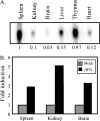

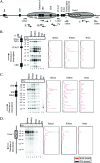
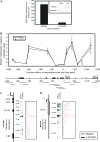
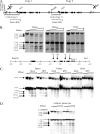
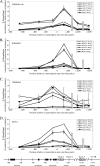
Similar articles
-
Weakly positioned nucleosomes enhance the transcriptional competency of chromatin.PLoS One. 2010 Sep 24;5(9):e12984. doi: 10.1371/journal.pone.0012984. PLoS One. 2010. PMID: 20886052 Free PMC article.
-
Proximity of H2A.Z containing nucleosome to the transcription start site influences gene expression levels in the mammalian liver and brain.Nucleic Acids Res. 2012 Oct;40(18):8965-78. doi: 10.1093/nar/gks665. Epub 2012 Jul 19. Nucleic Acids Res. 2012. PMID: 22821566 Free PMC article.
-
Genome-wide nucleosome mapping of Plasmodium falciparum reveals histone-rich coding and histone-poor intergenic regions and chromatin remodeling of core and subtelomeric genes.BMC Genomics. 2009 Dec 16;10:610. doi: 10.1186/1471-2164-10-610. BMC Genomics. 2009. PMID: 20015349 Free PMC article.
-
The specificity of H2A.Z occupancy in the yeast genome and its relationship to transcription.Curr Genet. 2020 Oct;66(5):939-944. doi: 10.1007/s00294-020-01087-7. Epub 2020 Jun 14. Curr Genet. 2020. PMID: 32537667 Review.
-
Patterning chromatin: form and function for H2A.Z variant nucleosomes.Curr Opin Genet Dev. 2006 Apr;16(2):119-24. doi: 10.1016/j.gde.2006.02.005. Epub 2006 Feb 28. Curr Opin Genet Dev. 2006. PMID: 16503125 Review.
Cited by
-
BRD4 is a histone acetyltransferase that evicts nucleosomes from chromatin.Nat Struct Mol Biol. 2016 Jun;23(6):540-8. doi: 10.1038/nsmb.3228. Epub 2016 May 9. Nat Struct Mol Biol. 2016. PMID: 27159561 Free PMC article.
-
Understanding the Impact of ErbB Activating Events and Signal Transduction on Antigen Processing and Presentation: MHC Expression as a Model.Front Pharmacol. 2016 Sep 26;7:327. doi: 10.3389/fphar.2016.00327. eCollection 2016. Front Pharmacol. 2016. PMID: 27729860 Free PMC article. Review.
-
Histone variants and chromatin structure, update of advances.Comput Struct Biotechnol J. 2022 Dec 5;21:299-311. doi: 10.1016/j.csbj.2022.12.002. eCollection 2023. Comput Struct Biotechnol J. 2022. PMID: 36582440 Free PMC article. Review.
-
Structural and Biochemical Characterization of the Nucleosome Containing Variants H3.3 and H2A.Z.Epigenomes. 2024 May 27;8(2):21. doi: 10.3390/epigenomes8020021. Epigenomes. 2024. PMID: 38920622 Free PMC article.
-
Antitumour immunity regulated by aberrant ERBB family signalling.Nat Rev Cancer. 2021 Mar;21(3):181-197. doi: 10.1038/s41568-020-00322-0. Epub 2021 Jan 18. Nat Rev Cancer. 2021. PMID: 33462501 Review.
References
-
- Albert, I., T. N. Mavrich, L. P. Tomsho, J. Qi, S. J. Zanton, S. C. Schuster, and B. F. Pugh. 2007. Translational and rotational settings of H2A.Z nucleosomes across the Saccharomyces cerevisiae genome. Nature 446572-576. - PubMed
-
- Berger, S. L. 2007. The complex language of chromatin regulation during transcription. Nature 447407-412. - PubMed
Publication types
MeSH terms
Substances
Grants and funding
LinkOut - more resources
Full Text Sources
Research Materials
